Brenner Base Tunnel
The Brenner Base Tunnel (German: Brennerbasistunnel; Italian: Galleria di base del Brennero) is a 55-kilometre-long (34 mi) railway tunnel under construction through the base of the Eastern Alps beneath the Brenner Pass. Upon completion, it will be the second or third longest railway tunnel in the world, after the Gotthard Base Tunnel in Switzerland and (depending on their relative completion dates) the Mont d'Ambin Base Tunnel between France and Italy. It will run from near Innsbruck, in Austria, to Franzensfeste, in Italy, replacing part of the current Brenner railway.[1] The line is part of Line 1, the Berlin to Palermo route, of Trans-European Transport Networks (TEN-T).
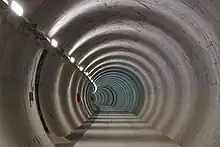 Exploratory Tunnel Aica–Mules | ||||||||||||||||||||||||||||||||||||||||||||||||||||||||||||||||||||||||||||||||||||||||||||||||||||||||||||||||||||||||||||||||||||||||||||||||||||||||||||||||||||||||||||||||||||||||||||||||||||||||||||||||||||||
| Overview | ||||||||||||||||||||||||||||||||||||||||||||||||||||||||||||||||||||||||||||||||||||||||||||||||||||||||||||||||||||||||||||||||||||||||||||||||||||||||||||||||||||||||||||||||||||||||||||||||||||||||||||||||||||||
|---|---|---|---|---|---|---|---|---|---|---|---|---|---|---|---|---|---|---|---|---|---|---|---|---|---|---|---|---|---|---|---|---|---|---|---|---|---|---|---|---|---|---|---|---|---|---|---|---|---|---|---|---|---|---|---|---|---|---|---|---|---|---|---|---|---|---|---|---|---|---|---|---|---|---|---|---|---|---|---|---|---|---|---|---|---|---|---|---|---|---|---|---|---|---|---|---|---|---|---|---|---|---|---|---|---|---|---|---|---|---|---|---|---|---|---|---|---|---|---|---|---|---|---|---|---|---|---|---|---|---|---|---|---|---|---|---|---|---|---|---|---|---|---|---|---|---|---|---|---|---|---|---|---|---|---|---|---|---|---|---|---|---|---|---|---|---|---|---|---|---|---|---|---|---|---|---|---|---|---|---|---|---|---|---|---|---|---|---|---|---|---|---|---|---|---|---|---|---|---|---|---|---|---|---|---|---|---|---|---|---|---|---|---|---|
| Location | Brenner Pass | |||||||||||||||||||||||||||||||||||||||||||||||||||||||||||||||||||||||||||||||||||||||||||||||||||||||||||||||||||||||||||||||||||||||||||||||||||||||||||||||||||||||||||||||||||||||||||||||||||||||||||||||||||||
| Status | Under construction | |||||||||||||||||||||||||||||||||||||||||||||||||||||||||||||||||||||||||||||||||||||||||||||||||||||||||||||||||||||||||||||||||||||||||||||||||||||||||||||||||||||||||||||||||||||||||||||||||||||||||||||||||||||
| System | Brenner railway | |||||||||||||||||||||||||||||||||||||||||||||||||||||||||||||||||||||||||||||||||||||||||||||||||||||||||||||||||||||||||||||||||||||||||||||||||||||||||||||||||||||||||||||||||||||||||||||||||||||||||||||||||||||
| Start | Innsbruck, Austria | |||||||||||||||||||||||||||||||||||||||||||||||||||||||||||||||||||||||||||||||||||||||||||||||||||||||||||||||||||||||||||||||||||||||||||||||||||||||||||||||||||||||||||||||||||||||||||||||||||||||||||||||||||||
| End | Franzensfeste, Italy | |||||||||||||||||||||||||||||||||||||||||||||||||||||||||||||||||||||||||||||||||||||||||||||||||||||||||||||||||||||||||||||||||||||||||||||||||||||||||||||||||||||||||||||||||||||||||||||||||||||||||||||||||||||
| Operation | ||||||||||||||||||||||||||||||||||||||||||||||||||||||||||||||||||||||||||||||||||||||||||||||||||||||||||||||||||||||||||||||||||||||||||||||||||||||||||||||||||||||||||||||||||||||||||||||||||||||||||||||||||||||
| Work begun | 2008 | |||||||||||||||||||||||||||||||||||||||||||||||||||||||||||||||||||||||||||||||||||||||||||||||||||||||||||||||||||||||||||||||||||||||||||||||||||||||||||||||||||||||||||||||||||||||||||||||||||||||||||||||||||||
| Constructed | 2007–present | |||||||||||||||||||||||||||||||||||||||||||||||||||||||||||||||||||||||||||||||||||||||||||||||||||||||||||||||||||||||||||||||||||||||||||||||||||||||||||||||||||||||||||||||||||||||||||||||||||||||||||||||||||||
| Opened | Scheduled 2032 | |||||||||||||||||||||||||||||||||||||||||||||||||||||||||||||||||||||||||||||||||||||||||||||||||||||||||||||||||||||||||||||||||||||||||||||||||||||||||||||||||||||||||||||||||||||||||||||||||||||||||||||||||||||
| Traffic | freight trains and passenger trains | |||||||||||||||||||||||||||||||||||||||||||||||||||||||||||||||||||||||||||||||||||||||||||||||||||||||||||||||||||||||||||||||||||||||||||||||||||||||||||||||||||||||||||||||||||||||||||||||||||||||||||||||||||||
| Character | Twin tube Passenger and freight Third exploratory tunnel | |||||||||||||||||||||||||||||||||||||||||||||||||||||||||||||||||||||||||||||||||||||||||||||||||||||||||||||||||||||||||||||||||||||||||||||||||||||||||||||||||||||||||||||||||||||||||||||||||||||||||||||||||||||
| Technical | ||||||||||||||||||||||||||||||||||||||||||||||||||||||||||||||||||||||||||||||||||||||||||||||||||||||||||||||||||||||||||||||||||||||||||||||||||||||||||||||||||||||||||||||||||||||||||||||||||||||||||||||||||||||
| Length | 64 km (40 mi) | |||||||||||||||||||||||||||||||||||||||||||||||||||||||||||||||||||||||||||||||||||||||||||||||||||||||||||||||||||||||||||||||||||||||||||||||||||||||||||||||||||||||||||||||||||||||||||||||||||||||||||||||||||||
| No. of tracks | Double track | |||||||||||||||||||||||||||||||||||||||||||||||||||||||||||||||||||||||||||||||||||||||||||||||||||||||||||||||||||||||||||||||||||||||||||||||||||||||||||||||||||||||||||||||||||||||||||||||||||||||||||||||||||||
| Track gauge | 1,435 mm (4 ft 8+1⁄2 in) standard gauge | |||||||||||||||||||||||||||||||||||||||||||||||||||||||||||||||||||||||||||||||||||||||||||||||||||||||||||||||||||||||||||||||||||||||||||||||||||||||||||||||||||||||||||||||||||||||||||||||||||||||||||||||||||||
| Electrified | Electrified 25 kV 50 Hz AC | |||||||||||||||||||||||||||||||||||||||||||||||||||||||||||||||||||||||||||||||||||||||||||||||||||||||||||||||||||||||||||||||||||||||||||||||||||||||||||||||||||||||||||||||||||||||||||||||||||||||||||||||||||||
| Operating speed | 250 km/h (160 mph) (passenger) 120 km/h (75 mph) (freight) | |||||||||||||||||||||||||||||||||||||||||||||||||||||||||||||||||||||||||||||||||||||||||||||||||||||||||||||||||||||||||||||||||||||||||||||||||||||||||||||||||||||||||||||||||||||||||||||||||||||||||||||||||||||
| Highest elevation | 840 metres (2,760 ft) | |||||||||||||||||||||||||||||||||||||||||||||||||||||||||||||||||||||||||||||||||||||||||||||||||||||||||||||||||||||||||||||||||||||||||||||||||||||||||||||||||||||||||||||||||||||||||||||||||||||||||||||||||||||
| Tunnel clearance | 8.1 metres (27 ft) | |||||||||||||||||||||||||||||||||||||||||||||||||||||||||||||||||||||||||||||||||||||||||||||||||||||||||||||||||||||||||||||||||||||||||||||||||||||||||||||||||||||||||||||||||||||||||||||||||||||||||||||||||||||
| Grade | Austria 7.4/1000 Italy 5/1000 | |||||||||||||||||||||||||||||||||||||||||||||||||||||||||||||||||||||||||||||||||||||||||||||||||||||||||||||||||||||||||||||||||||||||||||||||||||||||||||||||||||||||||||||||||||||||||||||||||||||||||||||||||||||
| Route map | ||||||||||||||||||||||||||||||||||||||||||||||||||||||||||||||||||||||||||||||||||||||||||||||||||||||||||||||||||||||||||||||||||||||||||||||||||||||||||||||||||||||||||||||||||||||||||||||||||||||||||||||||||||||
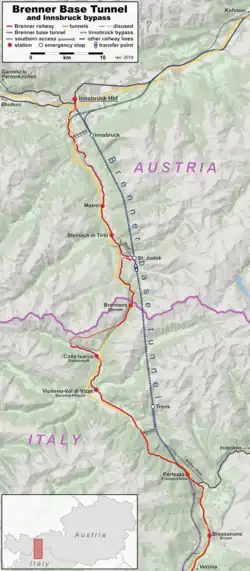 | ||||||||||||||||||||||||||||||||||||||||||||||||||||||||||||||||||||||||||||||||||||||||||||||||||||||||||||||||||||||||||||||||||||||||||||||||||||||||||||||||||||||||||||||||||||||||||||||||||||||||||||||||||||||
| ||||||||||||||||||||||||||||||||||||||||||||||||||||||||||||||||||||||||||||||||||||||||||||||||||||||||||||||||||||||||||||||||||||||||||||||||||||||||||||||||||||||||||||||||||||||||||||||||||||||||||||||||||||||
The Brenner Pass, in the Alps at the border between Austria and Italy, is one of the most important traffic connections between northern and southern Europe, and the motorway going over it is infamous for its frequent traffic jams.[2] Pollution from transit traffic is a major concern because of the combination of temperature inversion with the narrow shape of the valleys leading to the pass.[3]
The goal is to relieve this situation by greatly improving the railway connection between North Tyrol and South Tyrol with the new tunnel, which will allow trains to cross the Alps much faster. Currently, speeds in the Brenner region barely exceed 70 km/h (43 mph) due to the steepness of the existing tracks, which cross the pass at an elevation of 1,371 metres (4,498 ft) above sea level.[4]
The travel time from Innsbruck to Bolzano will be reduced from current 2 hours to just 50 minutes.[5]
The project is funded by Austria and Italy with large contributions by the European Union. Together with the Inntal Tunnel, part of the existing Innsbruck bypass, the Brenner Base Tunnel will reach a length of 64 kilometres (40 mi), which would be the longest underground railway connection in the world. The tunnel is scheduled to be completed in 2032.[6][7]
Background
The passenger and freight traffic across the Alps has increased greatly in recent years and further growth is forecast.[8] Austria is a key country in movement of freight between northern and southern Europe and between eastern and western Europe. The Brenner region is very politically sensitive with respect to both local and cross-border transport issues. Between 1970 and 1999, highway freight increased seven-fold. (3 million to 22 million tonnes) In 1990, 70% of the freight from eastern Europe was transported by rail and the remainder by trucks. These proportions were expected to reverse by 2010.[9]: 182ff About three-quarters of traffic through the Brenner Pass is currently carried by road transport. Local residents have long fought for relief from the associated pollution. The construction of a rail tunnel is considered by its proponents to be necessary for a shift of freight traffic from road to rail.
The railway line from Innsbruck to Bozen was built between 1860 and 1867. Tight curve radii and gradients of up to 2.6% complicate rail operations. However, improvements on the Italian side in recent years to the existing line, which were completed in late 2008, allow the line theoretically to accommodate 240 trains per day. The grades were not significantly improved.
The new Brenner line would have a maximum gradient of 0.4%-0.7%. Thus, a locomotive would be capable of hauling more than double the weight. The new line (the base tunnel together with the southern approach from Waidbruck/Ponte Gardena to Franzensfeste/Fortezza) would cut travel time between Innsbruck and Bolzano from about two hours today to less than half that.
Project
Main tunnel
The 55-kilometre (34 mi) long, twin-tube tunnel begins in the Innsbruck suburb of Wilten and penetrates the Alps reaching a height of about 840 metres (2,760 ft) above sea level (ASL). The tunnel will be up to 1,720 m (5,640 ft) below the surface at its deepest point in the gneiss section stretching south from the Italian border.[10] Since under the most recent plan the tunnel starts as a twin-tube tunnel, the junction already prepared in the Inntal tunnel on the Innsbruck bypass will not be used. Instead, a diversion with several branches is planned.
The volume of rock to be excavated during the construction of the tunnel is estimated at 21 million cubic metres (740 million cubic feet), of which approximately 60% will be incurred in Austria, as about 60% of the tunnel will be in Austria. A part of the spoil will be used as fill for the approach lines and another part of the spoil material is used to produce the concrete segment for the final lining of the tunnel. The main tunnels will have a circular cross section with a diameter of approx. 8.1 m (27 ft).
According to current planning the apex of the tunnel will be at the border at an altitude of about 810 m (2,660 ft) ASL, although an apex farther south would have been lower. The placing of the apex at the border is set out in the treaty between Austria and Italy. As justification for this choice it is stated that this will allow Austrian water to run in the tunnel to Austria and Italian water to Italy.
Northern approach
On its north end, the base tunnel (BBT) has two entrances, which must go underground a few kilometres before the junction with the main tunnels, and will also be built as part of the BBT. One route leads from the main Innsbruck station under Bergisel and the other connects with the Innsbruck bypass. This route adds about 8 kilometres (5.0 mi) more to the length of the tunnel than the Innsbruck station route; with it included, the BBT, at 62.7 kilometres (39.0 mi), would become the longest continuous railroad tunnel in the world. However, if the Axentunnel extension is added to the Gotthard Base Tunnel, its length would become 75 kilometres (47 mi), allowing it to reclaim the 'longest tunnel' title.
The northern approach from Munich within Germany is the 165 kilometres (103 mi) Grafing–Rosenheim–Kufstein route. The "Brenner Nordzulauf" (Brenner northern link) project aims to construct a high-speed line for speeds of up to 230 km/h (143 mph) between Grafing and Brannenburg in addition to the existing line, adapting the route's capacity to the projected increase as a result of the BBT. The project has reached in-depth planning stages but suffers from lacking support by locals.[11] A more direct route between Munich and Innsbruck, for example, via Garmisch-Partenkirchen, Mittenwald and Seefeld was not pursued, though it could have shortened the Munich Innsbruck line to 129 kilometres (80 mi).
In Austria, a new double-track high-speed line supplements the Lower Inn Valley railway between Wörgl and Baumkirchen. It manages to cut travel time between Munich and Innsbruck from 1:50 via the old tracks to merely 0:55 using the high-speed line.[12] About 32 kilometres (20 mi) of the 40-kilometre (25 mi) line through the Lower Inn Valley (Unterinntal) is built underground, in troughs, or under snow sheds. Noise and vibration mitigation is accomplished by the use of 80,000 square metres (860,000 sq ft) of elastomer in a mass-spring system. The segment's track superstructure is load class E5. It is capable of handling 260-300 trains per day.[1] This section was opened 2012-12-09.[13] Planning is under way on the continuation of this line to the German border at Brannenburg.
The southern approach for the BBT will be 189 kilometres (117 mi) long and reach from the southern portal of the tunnel in Franzensfeste/Fortezza to Verona. Planning has been completed for some sections.
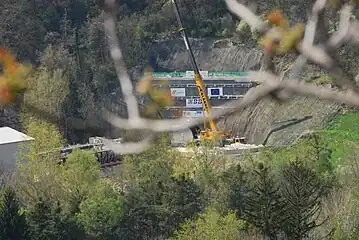
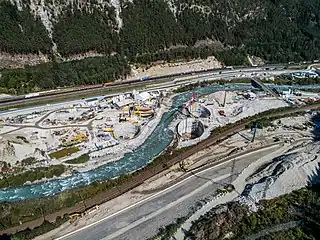 View of the Eisack underpass construction site in September of 2019
View of the Eisack underpass construction site in September of 2019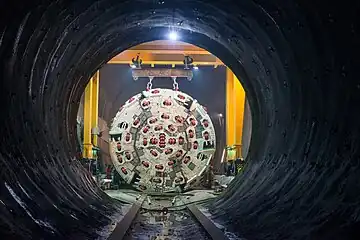
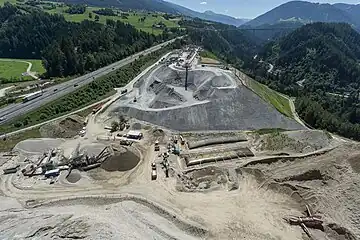 Excavation material processing plant and depot in Ahrental in July 2016
Excavation material processing plant and depot in Ahrental in July 2016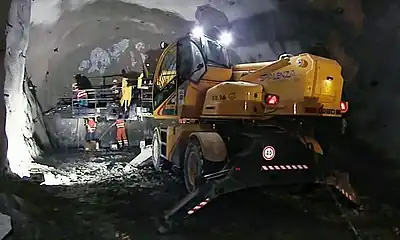 Dieci Pegasus telehandler working in the Brenner Base Tunnel in 2018
Dieci Pegasus telehandler working in the Brenner Base Tunnel in 2018
History
The Brenner tunnel is the most important link in the Berlin–Palermo railway axis, a series of projects that will create a single railway line from Berlin in Germany to Palermo in Sicily. In April 2003, the governments of Austria and Italy signed an agreement to build the tunnel.[14]
Schedule history
Early in the preliminary planning, at a Brussels meeting in June 2005, BBT SE (Brenner Base Tunnel Societas Europae), presented an interim status report. Expectations following the meeting were that the project could be finalized and the pilot tunnel started by 2006. The target for the tunnel to start service was 2015.[15][16]
In 2007 a construction timeline with a 2022 finish date was specified in a memorandum signed by the Austrian and Italian ministers of transport.[17]
Funding history
In December 2008 Antonio Tajani, the European commissioner for transport, approved funds totalling €1.7 billion to finance 11 railway projects that together should establish two major routes across the continent.[18][19]
In May 2009 it was confirmed that final go-ahead for the project had been given.[20]
The final estimated cost was put at €8.384bn at 2018 levels.[17]
Construction history
In the summer of 2007 work started on a pilot tunnel to run along the line of the future tunnel and to be used for removing water and spoil during the major construction phase. Construction of the pilot tunnel between 2006 and 2009 was estimated to cost €430 million and would be 50% EU funded.
On 6 July 2019, two Austrian segments were connected, and an unbroken 36 kilometres (22 mi) long tunnel was formed – around 65% of the tunnel's 55 kilometres (34 mi) projected length.[21]
Design
The final design will consist of two tunnels, 55 kilometres (34 mi) long. A centre tunnel 12 metres (39 ft) below the two primary tunnels will be used during construction as a guide tunnel to determine geological conditions, and later for drainage and emergency access. There will be a cross over between the tunnels every 333 metres (1,093 ft). Multi-function stations will be located at Trens (in Freienfeld), St. Jodok, and a third station towards the northern end of the tunnel to provide operational and emergency services. ETCS Level 2 will be installed to provide train control.[20]
Funding
As the transalpine stretch of the SCAN-MED Corridor, the Brenner Base Tunnel receives substantial funding from the European Union. Between 2015 and 2023, 50% of the costs for the exploratory tunnel (about 330 million Euro) and 40% of the costs for the two main tunnels (about 880 million Euro) were covered by the EU. Austria and Italy will each cover half of the remaining costs.
The 2017 estimate of the basic costs for the Brenner Base Tunnel was 7.8 billion Euro. Considering the planned end date for the project (2028), the estimate total costs, with risk provision and adjustment for inflation are about 8.384 billion Euro. They can be divided into 4 large categories: 60% of the cost comes from the engineering works, 15% is for outfitting, 10% is for planning, services and internal costs, 1% for parcels of land and related issues and 14% for risk provision.[22]
Specifications
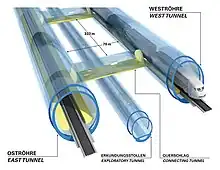
Source:[23]
- Total tunnel length from the Innsbruck bypass to Fortezza/Franzensfeste: 64 km (39.768 mi)
- Length from the Innsbruck portal to the Fortezza/Franzensfeste portal: 55 km (34.175 mi)
- Diameter of each of the single-track tubes: 8.1 m (27 ft)
- Distance between cross passage tunnels: 333 m (1,093 ft)
- Elevation at highest point: 794 m (2,605 ft)
- Maximum overburden: 1,720 m (5,640 ft)[10]
- Start of construction: 1999 (preparations), 2007 (exploratory section), 2011 (main tunnel)
- End of construction: 2032
- Total cost: €8.384 billion
- Electrification System: 25 kV 50 Hz AC
- Control and command system: ETCS Level 2
- Operating speed: 250 km/h (155 mph) for passenger trains and 160 km/h (99 mph) for freight trains
See also
References
- "Case Study: Northern Approach Line to the Brenner Base Tunnel" (PDF). getzner. September 2010. p. 4. Retrieved 2014-01-08.
- COKELAERE, HANNE (August 5, 2019). "Trucking hell in Tyrol". Politico. Retrieved 22 October 2020.
- de Franceschi, M.; Zardi, D. (March 2009). "Study of wintertime high pollution episodes during the Brenner-South ALPNAP measurement campaign". Meteorol Atmos Phys. 103 (1–4): 237–250. Bibcode:2009MAP...103..237D. doi:10.1007/s00703-008-0327-2. ISSN 1436-5065. S2CID 120275169.
- Bruzzo, Marco (18 August 2017). "Ferrovia del Brennero, 150 anni fa i primi treni". Tutto Treno Blog (in Italian). Archived from the original on 9 February 2018.
- Müller-Meiningen, Julius (2008-04-30). "Monumentales Superloch". Sueddeutsche Zeitung (in German). Archived from the original on 2008-05-23.
- Fender, Keith (27 May 2021). "Governors protest latest delay to Brenner Base Tunnel construction". International Railway Journal. Retrieved 23 August 2021.
- Brenner Base Tunnel Delayed Modern Railways issue 874 July 2021 page 80
- Pompigna, Andrea; Mauro, Raffaele (June 2020). "Input/Output models for freight transport demand: a macro approach to traffic analysis for a freight corridor". Archives of Transport. 54 (2): 21–42. Bibcode:2020ArTr...54...21P. doi:10.5604/01.3001.0014.2729. ISSN 2300-8830.
- ff Contemporary Issues and Debates in EU Policy: The European Union and ..., p. PA182 ff, at Google Books ISBN 071906418X
- Reynolds, Patrick (February 2011). "Brenner project takes a major leap forward". Tunnel Talk. Archived from the original on 2013-08-20. Retrieved 2013-08-14.
- "Aktuelles - Brenner-Nordzulauf". www.brennernordzulauf.eu. Archived from the original on 2019-04-10. Retrieved 2019-04-10.
- "Die Neue Unterinntalbahn auf höchstem Niveau Kundl-Baumkirchen" (PDF). BEG (in German). October 2007. Archived from the original (PDF) on 2017-08-08. Retrieved 2019-04-10.
- "Neue Unterinntalbahn: Highspeed und höchste Sicherheit" (PDF) (in German). ÖBB-holding AG. 2012-11-26. p. 3. Archived from the original (PDF) on 2013-09-30. Retrieved 2014-01-08.
- Brenner Base Tunnel Agreement International Railway Journal May 2003 page 2
- "EC welcomes progress - Brenner Base tunnel project". Infrasite.nl. 24 June 2005. Archived from the original on 4 March 2016. Retrieved 2013-08-16.
- "Commission welcomes progress of Brenner Base tunnel project" (Press release). European Commission. 23 June 2005. Retrieved 2013-08-06.
- van Miert, Karel (2007-09-10). "Annual activity report by the coordinator Karel Van Miert - PRIORITY PROJECT 1 Berlin-Verona/Milan-Bologna-Naples-Messina-Palermo rail link" (PDF). Archived (PDF) from the original on 2008-02-28. Retrieved 2007-12-09.
- "Brenner Tunnel: construction of the exploratory gallery begins" (Press release). European Commission. 2006-06-29. Archived from the original on 2009-08-31. Retrieved 2006-12-13.
- "TEN-T rail funding signed". Railway Gazette International. 5 December 2008. Archived from the original on 12 February 2011. Retrieved 2010-10-18.
- "Brenner base tunnel approved". Railway Gazette International. 11 May 2009. Archived from the original on 12 February 2011. Retrieved 2010-10-18.
- "Contractors celebrate Brenner exploratory tunnel breakthrough". 10 July 2020.
- "Funding". Brenner Base Tunnel. BBT SE. Retrieved 17 August 2020.
- "Project Overview". Brenner Base Tunnel. BBT SE. Archived from the original on 22 September 2012. Retrieved 19 February 2013.